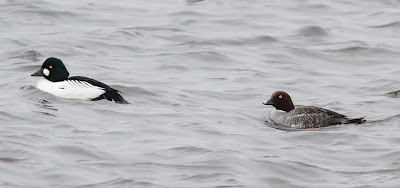There was really good birding to be had this morning as Redwings and Fieldfares arrived with a vengeance, the thrushes joined by a good number of Chaffinches and Siskins on the move. The only problem was that I worried that at any one time I might be in the wrong place and miss something elsewhere.
With such an overdue and predictable scenario of visible migration taking place it seemed a shame that throughout the morning I saw one other birder only, and he intent on disturbing everything in sight by displaying the field craft of a complete novice.
In the half-light I pulled into the gate at Braides Farm to look for the Buzzards which seem to spend nights out near the sea wall, effectively in the middle of nowhere. Sure enough the two of them were close together moving along the distant fence line, searching for food on the ground below or in the nearby farmer's midden.
Midden - Wiki - “early Scandinavian; Norwegian: mødding, Danish: mødding, Swedish regional: mödding) is an old dump for domestic waste which may consist of animal bone, human excrement, botanical material, vermin, shells, sherds, lithics (especially debitage), and other artifacts and ecofacts associated with human occupation.”
It’s been said a number of times on this blog. Buzzards do not spend much of their time hunting game birds. Released Pheasants and Red-legged Partridges make up a tiny proportion of a Buzzard’s diet. Buzzards are more likely to feed on carrion, supplementing that with reptiles, amphibians, larger insects and earthworms. There is no valid reason for persecuting Buzzards and no excuse whatsoever for killing them unlawfully.
Buzzard and Grey Heron
It would have been good to watch the Buzzards finding breakfast but I was intent on getting to Conder and Glasson after a Thursday morning walk to babysit Holly The Dog hinted at thrushes on the move.
There wasn’t a lot different on the pool or in the creeks. With one ear and one eye on the sky there followed the customary array of 140 Teal, 14 Little Grebe, 12 Snipe, 2 Goosander, 1 Common Sandpiper, 1 Kingfisher,1 Great Crested Grebe, 1 Little Egret and 1 Grey Heron.
Kingfisher
Just after 8am a couple of Reed Buntings dropped into the hedgerow and 2 calling Fieldfares flew south so I moved around to the elevated old railway line to watch from there. The southerly wind began to pick up quite noticeably but between 0830 and 0930 thousands of both Fieldfares and Redwings flew over in parties of anything of up to 300/400 strong, the birds arriving from the north and appearing to follow the tree line of the River Lune until they hit Conder Green.
Fieldfare
It was here that the flocks veered off into south westerly and westerly streams with just a very few Redwings stopping to feed. At first the flocks seemed to be Redwings mixed with a few Fieldfares but gradually turned to a stronger Fieldfare presence and by 0945 I had noted 1200 Redwings and 1400 Fieldfares. Chaffinches were using the same north to south flight lines, some remaining in the car park where I could also hear the pinging calls of more than one Siskin.
Chaffinch
I hoped to find grounded thrushes near the churchyard and in the hawthorns at Glasson but there were none. It had become too windy from the south with the trees and bushes flailing about.
On the water here were 55 Tufted Duck and the welcome return of a single Goldeneye.
Goldeneye
I decided to try Pilling where thrushes might have found the trees at Fluke Hall. Here it was windy too with a bank of grey cloud to the south and a reason perhaps that a flock of 400/500 Fieldfares headed over the sea wall but this time in a clear north easterly direction; an attempt to reorient to a different but visible route south? I saw no other Fieldfares and considered that migration here was over for the day at 1030 hours.
Fieldfares
Chaffinches were on the move here. A couple of small flocks flew in from the west along the sea wall and into the shelter of the wood where I found 40+ Chaffinches and 2 or more Siskins high in the treetops. Also in and around the wood I found a pair of Kestrel, 3 Buzzard, 1 Nuthatch, 2 Great-spotted Woodpecker, 2+ Goldcrest and 1 Pied Wagtail.
Kestrel
From the sea wall - 450 Pink-footed Geese on the stubble and 110 Whooper Swans on the marsh.
Whooper Swans
It was a fascinating but slightly frustrating morning, spoilt by the early sun turning quickly to cloud and as usual, the rapid increase in the wind strength. It's best not to be a churlish birder but while the morning was extremely interesting and at times exciting, there's no doubt it was also one of those “If Only” days.
Log in soon for more birding days with Another Bird Blog.
Linking today to Anni's blog and Eileen's Saturday Blog.
Linking today to Anni's blog and Eileen's Saturday Blog.






































.jpg)
























.jpg)













